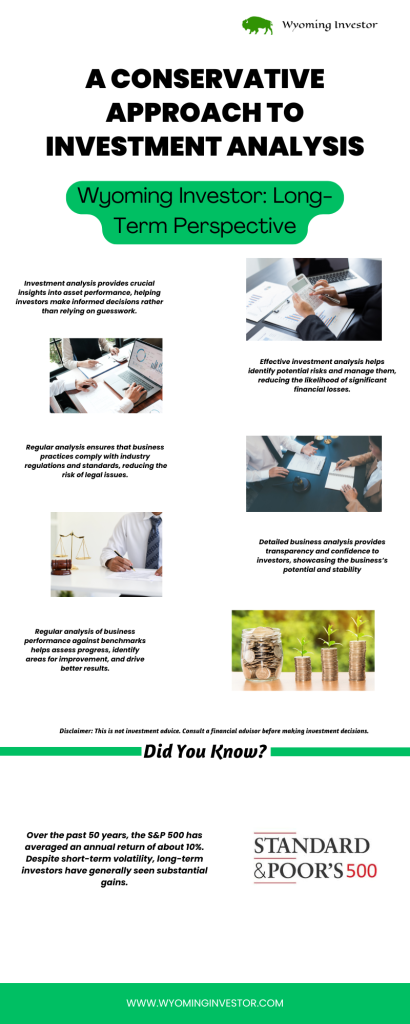Navigating Financial Stability: A Conservative Approach to Investment Analysis

In an increasingly unpredictable financial world, how can you safeguard your investments while still aiming for steady returns? Conservative investment analysis offers a strategic approach for those seeking to minimize risk and preserve capital. This method is particularly beneficial for individuals who prioritize stability and modest growth over the potential for high rewards coupled with significant risk. By focusing on low-risk investment options and carefully assessing their performance, conservative investing provides a pathway to financial security that appeals to risk-averse investors, such as retirees or those planning for long-term stability.
Understanding Conservative Investing
Conservative investing focuses on preserving capital while aiming for modest, consistent returns. Unlike aggressive strategies that chase high returns with higher risk, conservative investing prioritizes stability and gradual growth. This approach is particularly appealing to risk-averse individuals, such as retirees or those nearing retirement, who prioritize protecting their assets over seeking high returns.
Key Principles of Conservative Investment Analysis
-
Risk Assessment and Tolerance: The first step in conservative investment analysis is evaluating your risk tolerance. Conservative investors typically have a lower risk threshold and prefer investments that provide stability over high returns. This means avoiding assets that can fluctuate widely in value and instead opting for those with a track record of steady performance.
-
Diversification: Diversification is a cornerstone of conservative investing. By spreading investments across different asset classes—such as bonds, dividend-paying stocks, and cash equivalents—investors can mitigate the impact of poor performance in any single investment. The goal is to achieve a balanced portfolio that reduces risk while still providing potential for growth.
-
Focus on High-Quality Assets: Conservative investors tend to favor high-quality, low-risk assets. Government bonds, blue-chip stocks, and high-grade corporate bonds are examples of investments that are generally considered safer. These assets often have lower volatility and provide more predictable returns, making them ideal for a conservative investment strategy.
-
Income Generation: Generating a steady stream of income is a key objective for conservative investors. This can be achieved through investments such as dividend-paying stocks or bonds with regular interest payments. Income-generating investments help provide a cushion against market fluctuations and ensure a steady cash flow.
-
Long-Term Perspective: Conservative investing often involves a long-term perspective. Investors who adopt this approach are less concerned with short-term market movements and more focused on long-term stability and gradual growth. Patience and discipline are crucial, as conservative investments may take time to yield significant returns.
-
Regular Monitoring and Rebalancing: Even with a conservative strategy, regular monitoring and rebalancing of your portfolio are essential. This involves reviewing your investments periodically to ensure they align with your risk tolerance and financial goals. Rebalancing helps maintain your desired asset allocation and can prevent overexposure to any single investment type.
Navigating Political Uncertainty
As political dynamics shift, you might wonder how a potential change in leadership could impact your investments. With figures like Kamala Harris or Donald Trump potentially influencing the political landscape, it’s natural to question how their policies might affect your portfolio.
A win by Harris or Trump could bring different policy changes that might impact various sectors and industries. For example, shifts in tax policies, regulatory frameworks, or trade relations could alter market conditions and investment opportunities. However, no matter which candidate emerges victorious, the fundamental principles of conservative investing remain relevant.
If you’re seeking to secure your financial future through a conservative investment approach or explore how to start and grow a business with a focus on stability and prudent risk management, why not reach out to us? Our team of experienced advisors is here to provide personalized guidance tailored to your unique goals and risk tolerance. Whether you’re looking to refine your investment strategy, explore new opportunities, or embark on a new business venture, we can help you navigate the complexities with confidence. Contact us today to start a conversation about how we can assist you in achieving your financial objectives and setting the groundwork for long-term success.
The key takeaway is that while political events can influence market conditions, they do not dictate your investment success. A well-constructed conservative investment strategy focuses on risk management, diversification, and quality assets—factors that provide a stable foundation regardless of political shifts. By adhering to these principles, you can navigate political uncertainty with confidence, knowing that your investment approach is designed to withstand various scenarios.
Conservative Investment Strategies
-
Bond Investments: Bonds, especially those issued by stable governments or high-credit-quality corporations, are a cornerstone of conservative investing. They offer regular interest payments and are generally less volatile than stocks.
-
Dividend-Paying Stocks: Stocks from established companies that pay regular dividends can provide a steady income stream while offering the potential for capital appreciation. These stocks are typically less volatile than growth stocks and provide a buffer against market downturns.
-
Certificates of Deposit (CDs): CDs are low-risk investments with fixed interest rates and predetermined maturity dates. They offer guaranteed returns and are insured by the Federal Deposit Insurance Corporation (FDIC) up to certain limits.
-
Money Market Funds: Money market funds invest in short-term, high-quality investments and aim to provide liquidity with minimal risk. They are a safe place to park cash and provide a small, but stable, return.
Conclusion
Conservative investment analysis is about finding a balance between risk and reward. By focusing on risk assessment, diversification, high-quality assets, income generation, and long-term growth, you can build a portfolio that offers stability and protection. Regular monitoring and rebalancing ensure that your investments continue to align with your financial goals and risk tolerance.
Ultimately, conservative investing is a prudent approach for those who value security and gradual growth. With careful analysis and a disciplined strategy, you can safeguard your future and achieve steady progress towards your financial objectives—regardless of the political climate.
Disclaimer: The information provided in this article is for informational purposes only and should not be construed as investment advice. Always consult with a qualified financial advisor or professional before making any investment decisions. Investing involves risks, including the potential loss of principal, and individual investment choices should be based on personal financial circumstances and goals.

